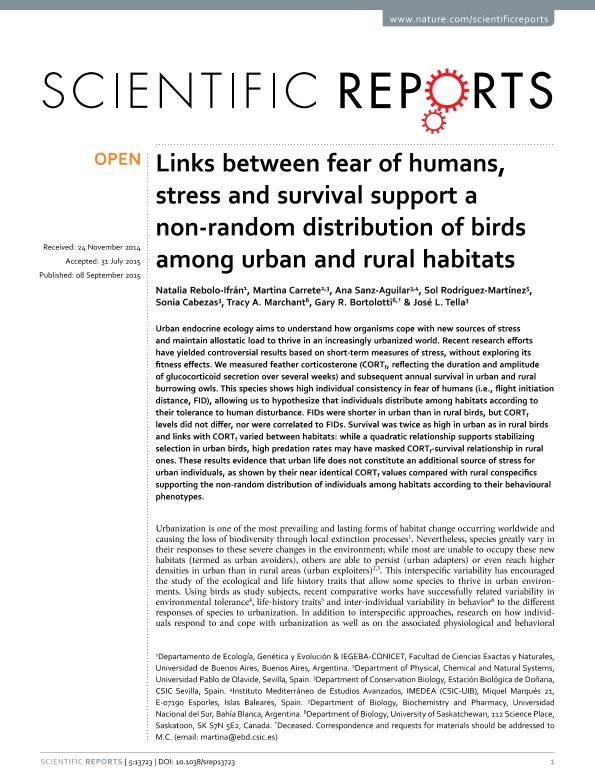Artículo
Links between fear of humans, stress and survival support a non-random distribution of birds among urban and rural habitats
Rebolo, Natalia ; Carrete, Martina
; Carrete, Martina ; Sanz Aguilar, Ana; Rodríguez, María Sol
; Sanz Aguilar, Ana; Rodríguez, María Sol ; Cabezas, Sonia; Marchant, Tracy A.; Bortolotti, Gary R.; Tella Escobedo, José Luis
; Cabezas, Sonia; Marchant, Tracy A.; Bortolotti, Gary R.; Tella Escobedo, José Luis
 ; Carrete, Martina
; Carrete, Martina ; Sanz Aguilar, Ana; Rodríguez, María Sol
; Sanz Aguilar, Ana; Rodríguez, María Sol ; Cabezas, Sonia; Marchant, Tracy A.; Bortolotti, Gary R.; Tella Escobedo, José Luis
; Cabezas, Sonia; Marchant, Tracy A.; Bortolotti, Gary R.; Tella Escobedo, José Luis
Fecha de publicación:
08/09/2015
Editorial:
Nature Publishing Group
Revista:
Scientific Reports
ISSN:
2045-2322
Idioma:
Inglés
Tipo de recurso:
Artículo publicado
Clasificación temática:
Resumen
Urban endocrine ecology aims to understand how organisms cope with new sources of stress and maintain allostatic load to thrive in an increasingly urbanized world. Recent research efforts have yielded controversial results based on short-term measures of stress, without exploring its fitness effects. We measured feather corticosterone (CORTf, reflecting the duration and amplitude of glucocorticoid secretion over several weeks) and subsequent annual survival in urban and rural burrowing owls. This species shows high individual consistency in fear of humans (i.e., flight initiation distance, FID), allowing us to hypothesize that individuals distribute among habitats according to their tolerance to human disturbance. FIDs were shorter in urban than in rural birds, but CORTf levels did not differ, nor were correlated to FIDs. Survival was twice as high in urban as in rural birds and links with CORTf varied between habitats: while a quadratic relationship supports stabilizing selection in urban birds, high predation rates may have masked CORTf-survival relationship in rural ones. These results evidence that urban life does not constitute an additional source of stress for urban individuals, as shown by their near identical CORTf values compared with rural conspecifics supporting the non-random distribution of individuals among habitats according to their behavioural phenotypes.
Palabras clave:
Stress
,
Fear Humans
,
Urban And Rural
,
Corticosterone
Archivos asociados
Licencia
Identificadores
Colecciones
Articulos(CCT - BAHIA BLANCA)
Articulos de CTRO.CIENTIFICO TECNOL.CONICET - BAHIA BLANCA
Articulos de CTRO.CIENTIFICO TECNOL.CONICET - BAHIA BLANCA
Articulos(IEGEBA)
Articulos de INSTITUTO DE ECOLOGIA, GENETICA Y EVOLUCION DE BS. AS
Articulos de INSTITUTO DE ECOLOGIA, GENETICA Y EVOLUCION DE BS. AS
Citación
Rebolo, Natalia; Carrete, Martina; Sanz Aguilar, Ana; Rodríguez, María Sol; Cabezas, Sonia; et al.; Links between fear of humans, stress and survival support a non-random distribution of birds among urban and rural habitats; Nature Publishing Group; Scientific Reports; 5; 8-9-2015; 1-10
Compartir
Altmétricas



